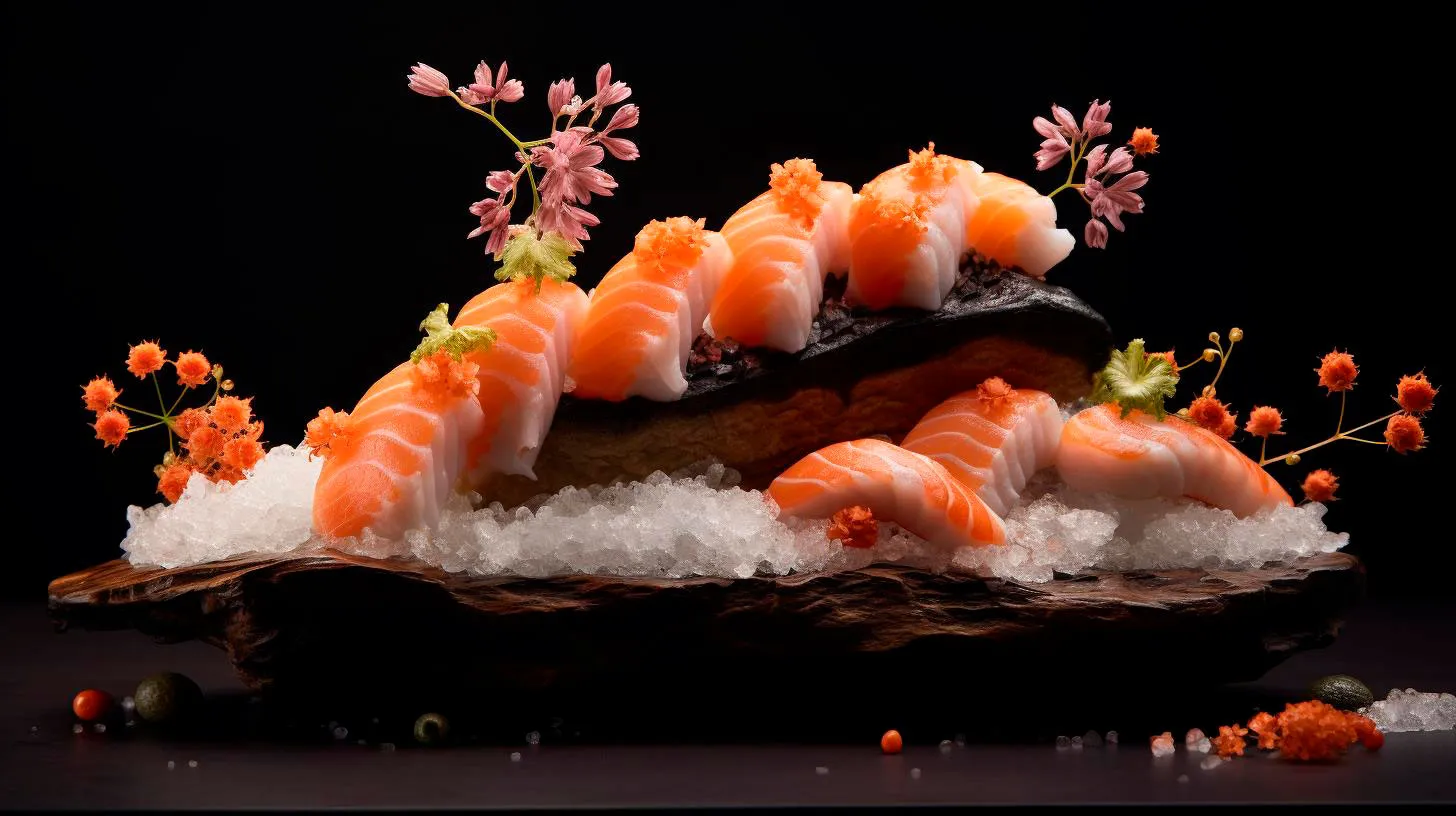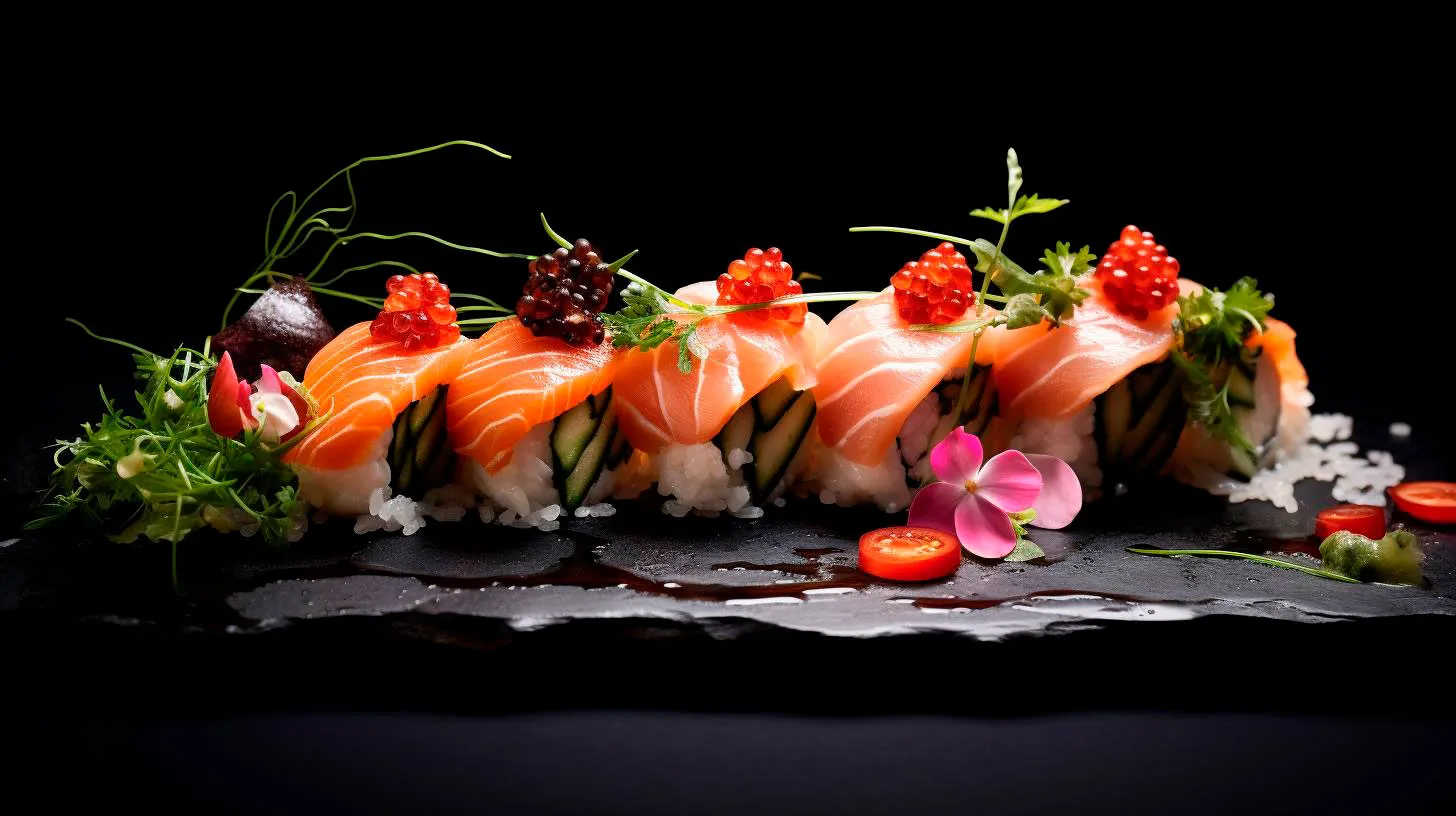The Ultimate Sushi Party Guide: How to Host the Perfect Sushi Gathering
Whether it’s a birthday celebration, a casual get-together with friends, or even a corporate event, hosting a sushi party is an excellent way to impress your guests. In this ultimate sushi party guide, we’ll dive into everything you need to know to create an unforgettable sushi extravaganza.
1. Plan Your Sushi Menu
Before hosting a sushi party, it’s essential to plan an enticing menu that caters to everyone’s tastes and dietary needs. Here are some pointers to consider:
- Offer a variety of sushi rolls including vegetarian, seafood, and meat options.
- Include popular sushi rolls like California rolls, spicy tuna rolls, and shrimp tempura rolls.
- Consider offering a mix of nigiri and sashimi for those who prefer a simpler approach.
- Don’t forget to add some vegetarian options such as avocado rolls, cucumber rolls, or sweet potato rolls.
- Consider adding a few cooked appetizers like gyoza (Japanese dumplings) or agedashi tofu to diversify the menu.
2. Source Fresh Ingredients
Freshness is key when it comes to sushi. To ensure the highest quality, source your ingredients from trusted suppliers or local fish markets. Here are some tips:
- Opt for the freshest fish possible, preferably from sustainable sources.
- If you’re uncertain about handling raw fish, focus on vegetarian or cooked options instead.
- Use high-quality sushi rice, nori (seaweed sheets), and other necessary sushi ingredients such as soy sauce, wasabi, and pickled ginger.
- Consider adding unique toppings like tobiko (flying fish roe) or sesame seeds to enhance the flavors and presentation of your sushi rolls.
3. Preparation and Presentation
The presentation of your sushi is just as important as its taste. Follow these steps to create visually appealing sushi:
- Invest in a good sushi rolling mat and sharp knives for precise cutting.
- Ensure your sushi rice is well-cooked, seasoned properly with rice vinegar, sugar, and salt, and cooled to room temperature for easy handling.
- Place a sheet of nori on the sushi rolling mat, spread a thin layer of sushi rice on top, leaving a border at the edge.
- Add your chosen fillings, and then roll tightly using the mat, applying gentle pressure to create a firm roll.
- Once rolled, use a sharp knife to cut the sushi roll into bite-sized pieces.
- Arrange the sushi beautifully on a platter or wooden board, adding garnishes and sauces for an inviting display.
4. Sake Pairing and Beverage Options
No sushi party is complete without refreshing beverages, and sake is undoubtedly the perfect choice. Consider these tips when selecting the right sake:
- Offer a range of sake options, including dry, sweet, and fruity varieties.
- Suggest sake pairings for different sushi rolls to enhance the experience.
- Not everyone may enjoy sake, so it’s crucial to have alternative beverage options such as green tea, Japanese soda, or non-alcoholic cocktails.
5. Sushi Party Decor and Ambiance
Create an atmosphere that immerses your guests in the world of sushi. Here are some ideas to set the perfect ambiance:
- Decorate your space with Japanese-inspired elements like origami, bamboo mats, or traditional fans.
- Play soft instrumental Japanese music or traditional tunes to add an authentic touch.
- Consider using dimmed lighting or candles to create a cozy and relaxed environment.
Key Takeaways
- Plan a diverse sushi menu that caters to all dietary preferences.
- Sourcing fresh and high-quality ingredients is essential for delicious sushi.
- Master the art of sushi preparation and presentation for visual appeal.
- Offer a selection of sake and other beverage options for guests.
- Create an inviting ambiance by incorporating Japanese-inspired decor and music.
With this ultimate sushi party guide, you’re ready to impress your guests and host an unforgettable gathering. From planning your menu to sourcing fresh ingredients and perfecting your sushi-making skills, your guests will be treated to an authentic sushi experience. So, roll up your sleeves, put on your chef’s hat, and get ready to create sushi magic!
DIY Party Tips: How to Host an Unforgettable Event
In this article, we’ll share some valuable party planning tips and DIY ideas to help you create a memorable experience for your guests. So let’s dive right in!
1. Define the style and theme
The first step in planning any party is to determine the style and theme that suits the occasion. Whether it’s a birthday celebration, an anniversary party, or a casual get-together, having a clear theme in mind will guide your decisions throughout the planning process. Choose a theme that reflects your personality or the interests of the guest of honor, and let it inspire your decorations, food, and overall ambiance.
- Consider popular themes such as “Hollywood Glam,” “Tropical Paradise,” or “80s Retro” to make your party standout.
- Use Pinterest and other platforms for inspiration and ideas.
- Ensure the theme aligns with the preferences and tastes of your guests.
2. DIY decorations for a personal touch
No party is complete without eye-catching decorations. Instead of relying on store-bought items, consider creating your own unique decorations. Not only will this save you money, but it will also give your party a personal touch that can’t be replicated. Here are a few ideas to get you started:
- Create a stunning photo backdrop by hanging a colorful sheet or a curtain of fairy lights.
- Make customized bunting using colorful paper, fabric, or even old photos.
- Design personalized centerpieces using mason jars filled with flowers or candles.
3. Delicious and budget-friendly homemade food
Food is an essential part of any party experience. Instead of breaking the bank with catering services or restaurant reservations, consider preparing homemade dishes that will delight your guests’ taste buds. Not only will this allow you to showcase your culinary skills, but it will also give you full control over the menu and your budget. Here are some ideas for homemade food:
- Create a colorful and refreshing fruit salad using a variety of seasonal fruits.
- Prepare bite-sized appetizers such as stuffed mushrooms or bruschetta.
- Offer a DIY food station with build-your-own tacos, sliders, or pizzas.
4. Engage guests with interactive activities
No one wants a dull party where guests are silently staring at their phones. Inject some entertainment and engagement into your event with fun and interactive activities. Depending on the theme and the preferences of your guests, you can consider the following:
- Set up a DIY photo booth with props and backdrops for hilarious pictures.
- Organize a themed costume contest with prizes for the most creative outfits.
- Plan interactive games like trivia, charades, or a DIY karaoke session.
5. Party favors to leave a lasting impression
Thank your guests for attending your party by sending them off with unique and thoughtful party favors. These small mementos will leave a lasting impression and serve as a reminder of the amazing time they had. Here are some ideas for creative party favors:
- Personalized keychains or coasters with the event date and a meaningful message.
- Homemade jams or cookies wrapped in cute packaging.
- A small potted plant or succulent as a symbol of growth and gratitude.
Key Takeaways
Planning a DIY party doesn’t have to be stressful. By defining a theme, creating personalized decorations, preparing homemade food, organizing engaging activities, and offering party favors, you can host an unforgettable event that your guests will rave about. Here’s a quick summary of the key takeaways:
- Choose a theme that suits the occasion and reflects your style.
- Get creative and DIY your decorations for a personal touch.
- Prepare homemade food to impress your guests without breaking the bank.
- Engage guests with interactive activities that match the theme.
- Send your guests home with thoughtful and unique party favors.
Now armed with these DIY party tips, it’s time to start planning your next unforgettable event. Remember, the most important thing is to enjoy the process and create an atmosphere where everyone feels welcome and has a great time!
Sushi Indulgence
In this article, we will explore the world of sushi, its origins, key ingredients, and the reasons why it has become an international sensation.
The Origins of Sushi
Sushi, derived from an ancient Japanese preservation method, has a rich history that dates back over a thousand years. Originally, the purpose of sushi was to preserve fish by fermenting it with rice and salt. During the Edo period in Japan, sushi evolved into the form we are familiar with today. The combination of vinegared rice and fresh fish began to gain popularity in Tokyo, eventually spreading across the country.
Key Ingredients
Sushi consists of a few essential ingredients that are carefully selected to create a harmonious and flavorful experience:
- Rice: The foundation of sushi, rice is the key component that binds the dish together. Short-grain Japanese rice, known for its stickiness when cooked, is ideal for sushi.
- Fish: The quality and freshness of fish are paramount when it comes to sushi. Popular fish varieties used in sushi include tuna, salmon, yellowtail, and mackerel, among others.
- Seaweed: Also known as nori, dried seaweed is used to wrap sushi rolls. It adds a distinct umami flavor and provides a satisfying crunch.
- Vegetables and Fillings: Sushi offers a wide range of fillings, including cucumber, avocado, carrots, and various seafood and meat options. These ingredients add texture, flavor, and color to sushi rolls.
- Condiments and Garnishes: Soy sauce, wasabi, and pickled ginger are often served alongside sushi to enhance the overall taste experience.
The Sushi Sensation
The popularity of sushi has reached astounding levels, making it a global culinary phenomenon. Here are some key reasons why sushi has become a favorite among food enthusiasts:
- Health Benefits: Sushi is considered a healthy choice due to its minimal use of oil and emphasis on fresh ingredients. The high omega-3 fatty acid content in fish provides numerous health benefits, including improved heart health and brain function.
- Diverse Options: With a vast array of fillings, sushi caters to a wide range of dietary preferences. From vegetarian options to indulgent selections like the famous fatty tuna, there is something for everyone.
- Visual Delight: Sushi’s presentation is a feast for the eyes. Chefs take great pride in crafting beautiful, vibrant plates that are as visually appealing as they are delicious.
- Cultural Appreciation: Sushi provides an opportunity to experience and appreciate Japanese culture. From the precision of sushi preparation to the artistry involved in plating, it offers a glimpse into an ancient culinary tradition.
Key Takeaways
Sushi’s journey from ancient preservation method to beloved international dish is a testament to its irresistible appeal. Here are some key takeaways to remember:
- Sushi originated in Japan as a means of preserving fish.
- Key ingredients of sushi include rice, fish, seaweed, vegetables, and condiments.
- Sushi has gained worldwide popularity due to its health benefits, diverse options, visual appeal, and cultural significance.
So the next time you have a craving for an exquisite dining experience, consider indulging in the flavorful world of sushi. Whether you opt for traditional nigiri, hand rolls, or creative fusion creations, sushi is sure to captivate your palate and leave you craving for more.
The Ultimate Guide to a Delicious Sushi Experience
History and Origins
Originating in Japan, sushi has a rich history dating back to the 8th century. The earliest form of sushi, known as narezushi, was developed as a way to preserve fish by fermenting it with rice and salt. This method allowed the fish to be stored for months, providing an essential food source during times of scarcity.
Over time, sushi evolved into the modern delicacy we know today. The 19th century saw the introduction of nigiri sushi, where a slice of fresh fish was placed on a small mound of vinegared rice. This style became immensely popular and gradually spread worldwide.
The Art of Sushi Making
Sushi making is not just a culinary skill; it is an art form. Skilled sushi chefs, known as itamae, dedicate years to perfecting their craft. The meticulousness and attention to detail displayed during the sushi-making process are truly awe-inspiring.
Here are some key steps in creating a mouthwatering sushi masterpiece:
- Selecting the Freshest Ingredients: Sushi revolves around fresh seafood and other high-quality ingredients. The taste and texture of the fish play a crucial role in the overall sushi experience.
- Preparing the Rice: Sushi rice, known as shari, is a special variety of short-grained rice seasoned with vinegar, sugar, and salt. It should be cooked to perfection – firm yet tender.
- Cutting Techniques: A skilled itamae knows exactly how to slice the fish to achieve the perfect thickness and texture. Each cut is precise and contributes to the overall mouthfeel of the sushi.
- Creative Presentation: Sushi is not just about taste; it is also a visual delight. The chef carefully arranges the different ingredients, adds garnishes, and presents the final dish with elegance.
The Health Benefits of Sushi
Aside from its delicious flavors, sushi offers several health benefits that make it an ideal choice for health-conscious individuals. Here are some key advantages:
- High in Nutrients: Sushi is packed with essential nutrients like omega-3 fatty acids, vitamins, and minerals. These help support brain function, promote heart health, and strengthen the immune system.
- Low in Calories: Sushi is relatively low in calories compared to other popular fast food options. It’s a great choice for those looking to maintain a healthy weight or achieve weight loss goals.
- Rich in Antioxidants: Many sushi ingredients, such as seaweed and fish, contain antioxidants that help combat free radicals and reduce the risk of chronic diseases.
Key Takeaways
Let’s recap the key takeaways from this guide:
- Sushi has a fascinating history that dates back to the 8th century in Japan.
- The art of sushi making requires skill, precision, and attention to detail.
- The freshness and quality of the ingredients are paramount in crafting delicious sushi.
- Sushi offers numerous health benefits, including omega-3 fatty acids and antioxidants.
- It’s a low-calorie option, making it ideal for those watching their weight.
So, the next time you crave a uniquely delightful dining experience, treat yourself to some sushi. Whether you opt for traditional nigiri, creative rolls, or delicate sashimi, the world of sushi is guaranteed to leave your taste buds wanting more!


